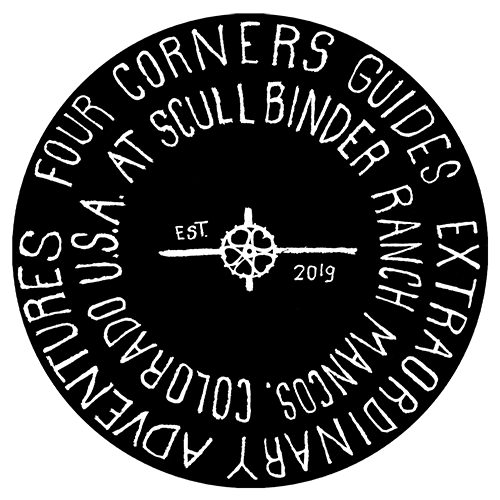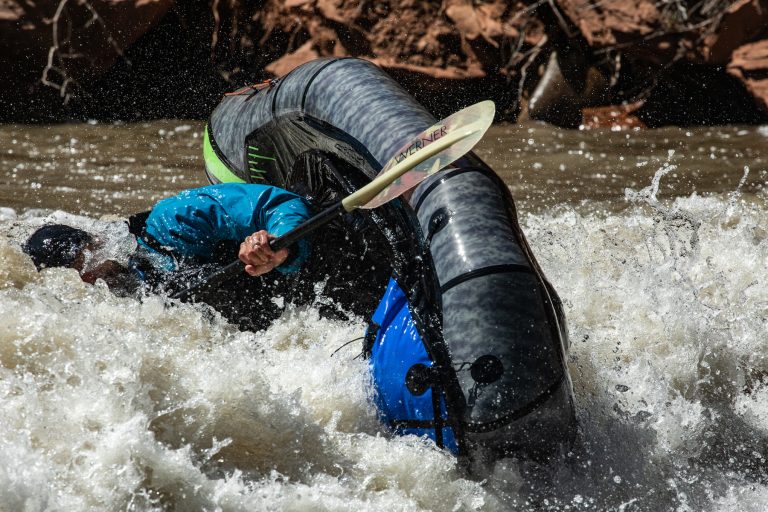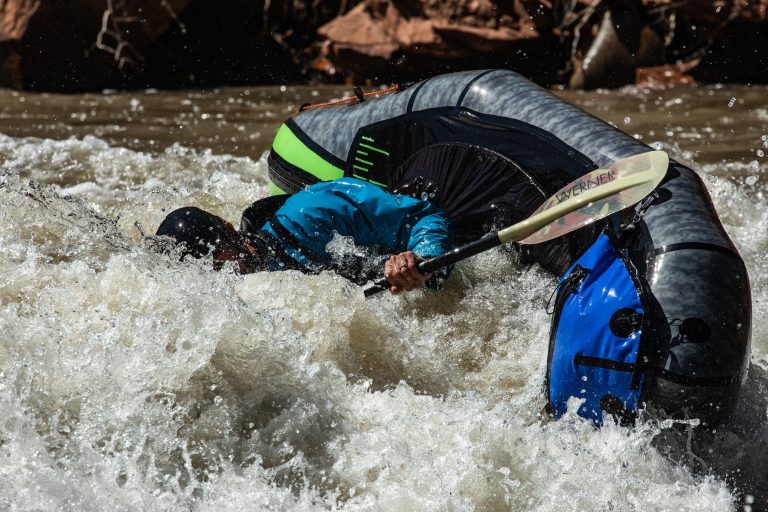Story & video by Waldo Aguayo. Photos by Andrew Burr.
rolling a packraft
Most packrafters or people who know about these boats wonder if it is possible to perform the famous “roll” in packraft. As the owner of a guide service (Scouting Rios Packrafting School) and an avid Chilean Packrafter (there aren’t many of us!), people always asked me this question.
The idea of rolling a packraft caught my attention when I first started in this discipline. Was it a party trick as some claimed? Or a valid technique that would improve my overall packrafting experience?
For older people with shoulder injuries or people who don’t plan on running challenging, technical whitewater, the wet re-entry (aka self rescue) is generally a sufficient and more foolproof technique. Four Corners Guides owner, Steve “Doom” Fassbinder, prefers the wet re-entry, aka self rescue.
“I can quickly and easily self rescue anytime, even in the middle of even the biggest rapids of the Grand Canyon,” he explains. He doesn’t want to invest the time, money or energy into kayaking, which, FCG’s advanced course instructor, Dan Thurber, says, “is the much easier way to learn a roll in a kayak.” I agree, as you will read more about below.
why i decided to learn to roll a packraft
I wanted to learn to roll from the start, as I planned on pushing my packrafting abilities as far as I could. I saw friends and others online who had their rolls, and it inspired me. For example, one friend recently did his first combat roll in the middle of a Class IV rapid. And rather than take a long, potentially dangerous swim, he found himself upright immediately, finishing the rapid in style. That’s enough to convince me of the value of rolling a packraft.
How I got started
Thus, two winters ago I started my training to achieve the roll in my packraft. Winter is not the best time to get into the water in this part of the planet—the Chilean Patagonia. I live in Puerto Rio Tranquilo, Aysen Region, Chile. Most of my training for the roll was on the shores of Lake General Carrera. With its very cold waters, I had to select my equipment well to be able to spend hours in the water. I understood from the beginning that the roll would not come easily my packraft.
With many layers of clothes under my dry suit, neoprene cap and goggles for the water I started the exercises. The first days I didn’t come close, though I watched all the videos I could find on YouTube. But practice makes perfect. And after several days trying about 30 rolls (which ended up being great self-rescue training), I had to change tactics.
Learning From Kayakers
So I turned to some kayaker friends for help. With their instruction I managed to understand the complete movement underwater and achieve the “C to C Roll” and the “Sweep Roll” in sea and whitewater kayak.
Now I just needed to take these new movements that my body had learned to the packraft. I had already been kayaking for several days, and I felt ready! This new technique would change everything I did in the water!
However, when I went back to training with the packraft, I continued to fail repeatedly (thus perfecting my self-rescue training or wet re-entry 😂). I grew frustrated, but continued until one afternoon, surprise! I got the roll in the packraft! I could not believe it. I tried again, and succeeded. I went out to celebrate with my friends. Then a few days later I started training again, and repeatedly failed!
Just Keep on Keeping on…
I’ve experienced many ups and down learning to roll my packraft. But currently in flatwater, I do it almost every time. And I am most successful when I mix the two rolls I learned from my kayak buddies, adding in leaving my head well behind in the packraft (more on this in my detailed explanation of how to roll a packraft below). In fact, I got so used to this movement that I now do it the same way in both my kayak and my packraft.
I still have to train more, as I am unable to regularly do it in rapids. My first reaction is always to do the wet re-entry, which technically speaking is the safest option if you still don’t have a completely solid roll in packraft. But eventually I will be rock solid!


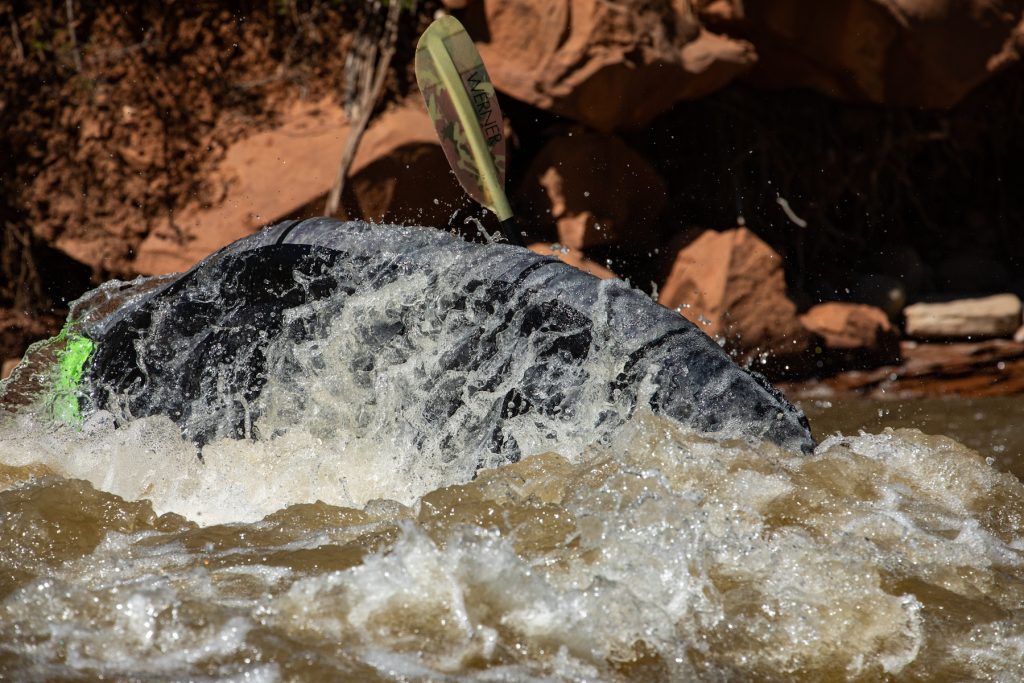
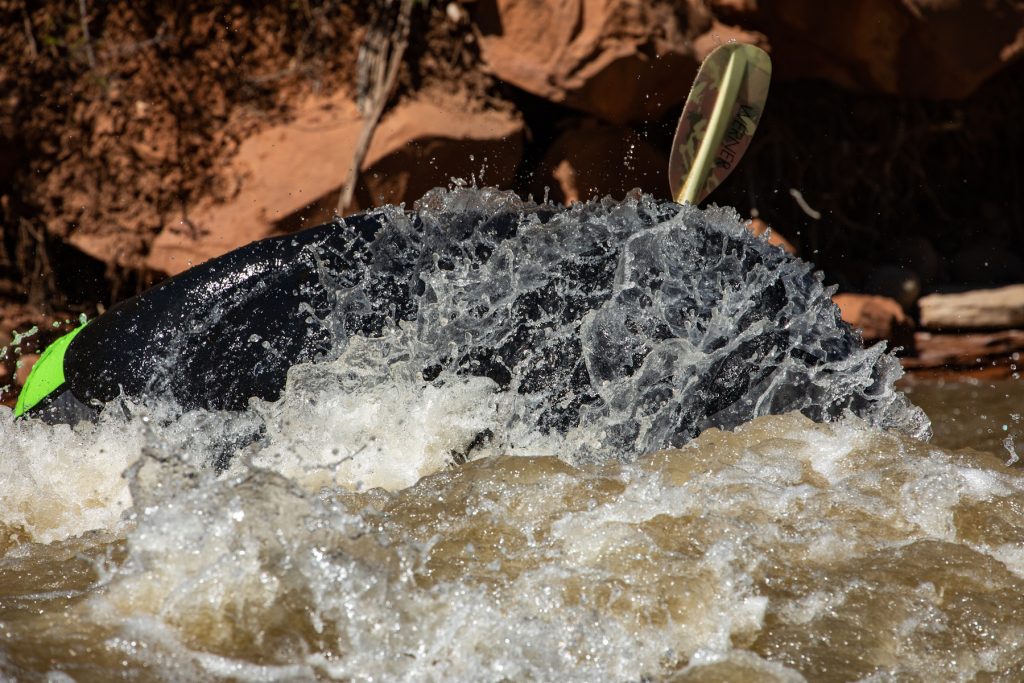
stages of a roll
In this explanation, I will focus more on the explanation of a “Sweep Roll”, as it has been the roll I most commonly practice. As complementary material I edited a short video to understand a little more the movements and steps of the roll.
The roll consists of four stages:
- Set Up
- Pause
- Sweep and Hip Snap
- Finish Position
Set Up
The first position for the roll will be with the paddle on the side of the boat, you can start with the power face of the paddle facing the sky from the beginning if you prefer. It is also easier to practice at the beginning with a sea kayak paddle, as the reach is longer, making the roll a little easier.
Now it’s time to flip the packraft. Stay in the underwater position, push the paddle towards the sky, trying to get the hands and paddle out of the water, the paddle power face resting on the surface of the water.
Pause
Continuing in the Set-Up position, it is advisable and also one of the most difficult moments when learning the roll, to take a pause at this point, to make sure you adopt the correct position for the Sweep and Hip Snap.
Then lean your body to the side of the boat to bring your head and body as close to the surface of the water as possible.
Sweep and Hip Snap
With the paddle we will start to do the sweep, trying to get a wide arc. It is important that at the beginning of the sweep, at the same time with the hips and knees we make the necessary torque to turn the boat back up. These movements done simultaneously will rotate our boat.
Finish Position
This is where the roll movement changes more in packraft than in kayak. At the end of the roll, we must try to bring our body and head as close to the back of the boat as possible. The head will always be the last part of the body to come out of the water. But in packrafting we also have to come out of the water trying to move our body mass to the back to achieve the roll.
Once the roll is achieved, we have to try to move again the body mass to the front of the boat and adopt a paddling position to be prepared for whatever comes, because if we continue with our body and head back, we will not have much stability and support points.
As I mentioned before, the most important safety maneuver to train is the wet re-entry. But the idea of training a solid roll in packraft is a striking goal.
Questions? Comments? Let Us Know what you think
Hey packrafters! What has worked for you when learning or mastering your roll? Please comment in the comments section below, or on our Instagram, Facebook or Packrafting Revolution posts. We’ll post a few of your comments here as well.
Ben Phillips, one of FCG’s Advanced Packrafting Instructors (photographed below and in the feature photo): “There are some other techniques out there besides the backward lean, which is typically not good form in a kayak. But it certainly helps get it done in a packraft.”
More comments below!
Comments
Mitch Flanigan: “I learned how to roll in a hard shell and bought a packraft because it opened up more options for living in Alaska. I feel very comfortable rolling the hardshell but the packraft is more difficult. I originally Owned the Gnarwhal but it was too difficult to roll due to how wide it is… sold it. Bought a Valkyrie and love it! It’s the closest to being in a hardshell that ive seen. It had an inflatable floor which not only makes it more rigid but helps the boat get on an edge and also makes it easier to roll. I still struggled rolling it at first and found that by deflating the seat (the Valkyrie has both an inflatable floor and a seat that sits on top of it), it was a lot easier to roll. By deflating the seat, it gives you a lower center of gravity and therefor easier to roll it over. I now only inflate the seat ~halfway for most trips”
Patrick Do: “Proper instruction to prevent injuries. And Learning to hand roll a kayak helped tremendously.“
Credits
Thanks to Franco Flores and Ignacio Saez for filming the videos. Likewise, to the brands that support me to continue practicing this discipline even in winter and finally to Lizzy and Doom for the opportunities to continue working and collaborating with Four Corners Guides.
